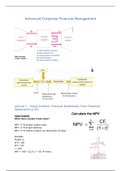Comparative Anatomy and Physiology in Animals
Lecture 5 Respiration in Invertebrates 27/10/20
Composition of air
- Nitrogen: 78.084%
- Oxygen: 20.946%
- Carbon dioxide: 0.04%
Diffusion
- A physical process by which ions or molecules move from a region of greater concentration
to a region of lesser concentration.
Fick’s Law
- R=D*A*(dp/d)
- R= the rate of diffusion.
- D= the diffusion constant.
- A= the area over which diffusion takes place.
- dp= the difference in their partial pressures between the interior of the organism and the
external environment.
- d= the distance across which diffusion takes place.
Respiratory medium
- Air- 21%, thinner at high altitudes, easy to ventilate.
- Water- O2 amount much less than and (0.0015%), O2 lower in warmer water, and harder to
ventilate.
- Air is a better respiratory medium than water.
Structure of the gas exchange surface
- The size of the organism
- Where it lives- water or land
- The metabolic demands of the organism- high, moderate, or low.
Gas exchange surfaces
- Large surface area
- Small diffusion distance
- Moist
- Maintains favourable concentration gradient
- Circulatory system may work at the same time as the gas exchange system to maintain the
concentration gradient
Respiration in Mollusca
- Snails: Hemocyanin in haemolymph, open circulatory system (has copper instead of iron).
Respiration in Gastropods
- Snails and slugs: haemocyanin in most, in family Planorbidae use haemoglobin.
Annelida
- Earthworms: Generally, takes place through the skin. In aquatic forms it goes through gill
filaments. Either haemoglobin or chlorocruorin as respiratory pigment.
Arthropoda
- Arachnids: open system, O2 and CO2 carried by haemocyanin in haemolymph. Trachea and
book lungs
- Crustaceans: gills protected by exoskeleton. They are featherlike and attached to the basal
segments of the legs. Open circulatory system, use haemolymph, with haemocyanin.
- Insects: open circulatory system, haemolymph with probably haemocyanin?
Lecture 5 Respiration in Invertebrates 27/10/20
Composition of air
- Nitrogen: 78.084%
- Oxygen: 20.946%
- Carbon dioxide: 0.04%
Diffusion
- A physical process by which ions or molecules move from a region of greater concentration
to a region of lesser concentration.
Fick’s Law
- R=D*A*(dp/d)
- R= the rate of diffusion.
- D= the diffusion constant.
- A= the area over which diffusion takes place.
- dp= the difference in their partial pressures between the interior of the organism and the
external environment.
- d= the distance across which diffusion takes place.
Respiratory medium
- Air- 21%, thinner at high altitudes, easy to ventilate.
- Water- O2 amount much less than and (0.0015%), O2 lower in warmer water, and harder to
ventilate.
- Air is a better respiratory medium than water.
Structure of the gas exchange surface
- The size of the organism
- Where it lives- water or land
- The metabolic demands of the organism- high, moderate, or low.
Gas exchange surfaces
- Large surface area
- Small diffusion distance
- Moist
- Maintains favourable concentration gradient
- Circulatory system may work at the same time as the gas exchange system to maintain the
concentration gradient
Respiration in Mollusca
- Snails: Hemocyanin in haemolymph, open circulatory system (has copper instead of iron).
Respiration in Gastropods
- Snails and slugs: haemocyanin in most, in family Planorbidae use haemoglobin.
Annelida
- Earthworms: Generally, takes place through the skin. In aquatic forms it goes through gill
filaments. Either haemoglobin or chlorocruorin as respiratory pigment.
Arthropoda
- Arachnids: open system, O2 and CO2 carried by haemocyanin in haemolymph. Trachea and
book lungs
- Crustaceans: gills protected by exoskeleton. They are featherlike and attached to the basal
segments of the legs. Open circulatory system, use haemolymph, with haemocyanin.
- Insects: open circulatory system, haemolymph with probably haemocyanin?


